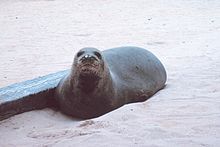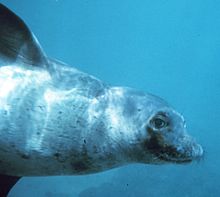Hawaiian monk seal
| Hawaiian Monk Seal | |
|---|---|

| |
| Scientific classification | |
| Kingdom: | |
| Phylum: | |
| Class: | |
| Order: | |
| Family: | |
| Genus: | |
| Species: | M. schauinslandi
|
| Binomial name | |
| Monachus schauinslandi Matschie, 1905
| |
The Hawaiian monk seal, Monachus schauinslandi, is an endangered earless seal that is endemic to the Hawaiian Islands[2].
Known to the native Hawaiians as ʻIlio-holo-i-ka-uaua, or "dog that runs in rough water," it received its scientific name Monachus schauinslandi when Dr. H. Schauinsland discovered the first skull known to science on Laysan Island. Its common name derives from its round head covered with short hairs, giving it the appearance of a medieval friar. The name may also reflect the fact that it lives a solitary existence relative to other species that collect in large colonies. Hawaiian monk seals are the most primitive living members of the Family Phocidae, having separated from other true seals perhaps 15 million years ago.
Description
Monk seal pups are born with a woolly black coat which is shed through a process called molting at the end of their nursing period. The birth coat is replaced by juvenile pelage which is silvery gray on the back and sides and white on the belly, chest and throat. Under exposure to sunlight and seawater, the juvenile pelage changes gradually in color to a dull brown as is found in adults.
Adult monk seals, like elephant seals, display an unusual type of molt each year in which the outer layer of skin is shed along with the old hair. Adult males molt in late summer and fall. Female monk seals usually molt after weaning their pups. Molting allows the seals' hair and upper layer of skin, which are subject to constant wear and tear, to be replaced. The new hair which develops is able to provide better insulation for the winter months ahead in the case of the males, or for females, after the nursing period when the mothers have used up much of their fat reserves.
A number of Hawaiian monk seals sport scars from shark attacks or injuries from fishing gear. Females are often scarred by encounters with males, which can be particularly brutal during sex. Adult males are 300 to 400 pounds (140 to 180 kg) in weight and 7 feet (2.1 m) in length while adult females tend to be much larger, being 400 to 600 pounds (180 to 270 kg) pounds and 8 feet (2.4 m) feet in length. Pups average 30 to 40 pounds (14 to 18 kg) at birth and 40 inches (1.0 m) in length. They get much larger, weighing in between 150 to 200 pounds before they stop nursing. Life expectancies are 25 to 30 years.
Endangered status
The Hawaiian monk seal is among the most endangered of all seal species, although its cousin species the Mediterranean Monk Seal (M. monachus) is even rarer, and the Caribbean Monk Seal (M. tropicalis), last sighted the 1950s, was officially declared extinct in June 2008.[3] The population of Hawaiian monk seals is in decline. In 2010, it was estimated that only 1100 individuals remain. It is listed as critically endangered.[4] The Hawaiian monk seal was officially designated as an endangered species on November 23, 1976, and is now protected by the Endangered Species Act and the Marine Mammal Protection Act.
Today, even though the islands are protected, many scientists believe that the effects of human activity along these fragile coastlines (and in the world at large) are still taking their toll[5]
It is illegal to kill, capture or harass a Hawaiian monk seal.
To raise awareness for the species' plight, the Hawaiian monk seal was declared Hawaii's official State Mammal on June 11, 2008 by Lieutenant Governor James Aiona.[6]
Threats


Seal populations have declined rapidly in recent years due to the rapid spread of human activity to even the most remote and isolated areas in the Hawaiian Islands. In the nineteenth century, Hawaiian Monk Seals were clubbed to death by whalers and sealers for meat, oil and skin.[7] U.S. forces hunted them during World War II while occupying Laysan Island and Midway.[7]
Predation by sharks, such as the tiger shark, reduced pup survival. As the result of human disturbances, ciguatera poisoning, high male to female ratios occurred during the breeding season, and entanglement in fishing nets and debris have killed many animals. In the northwestern Hawaiian islands, starvation is a serious problem. Lobsters, the seals' preferred food other than fish, have been overfished and competition from other apex predators such as sharks, jacks, and barracudas, leaves little left over for developing pups. The creation of Papahānaumokuākea Marine National Monument enclosing these islands may lead to more abundant food supplies.
In areas where male seals outnumber females, several males may compete for a single female, known as mobbing, often accidentally killing the female. Females of any age including pups can become targets.[8]
These threats have taken a toll on the species. It has been nearly eradicated from the main Hawaiian Islands. The population there is approximately 150.[9] It is currently found on Laysan, Midway, Pearl and Hermes Atoll, French Frigate Shoals, and Lisianski.[9]
In the summer of 2009, two monk seals were shot and killed.[10] Slowly, however, the monk seals are returning to the main Hawaiian Islands. Lone seals have been sighted in surf breaks and on beaches in Kauaʻi, Niʻihau, Maui, and O'ahu's Turtle Bay[11] and some of the other islands. They often leave the water haul out on busy tourist beaches, where they are vulnerable to disturbance. In early June 2010, 2 seals were seen hauled out on Oahu's popular Waikiki beach. NOAA has cultivated a network of volunteers who protect the seals while they bask or bear and nurse their young. In 2006, twelve pups were born in the main Hawaiian Islands, rising to thirteen in 2007, and eighteen in 2008. As of 2008 43 total pups have been counted in the main Hawaiian islands.[12]
NOAA is funding considerable research on seal population dynamics and health in conjunction with the Marine Mammal Center.
References
- ^ Template:IUCN2008 Listed as Critically Endangered (CR A3ce+4ce)
- ^ Hawaiian Monk Seal, Monachus schauinslandi
- ^ "Feds: Caribbean Monk Seal Officially Extinct". Fox News. 2008-06-09.
- ^ The Captive Care and Release Research Project Seeks to Aid Recovery of the Endangered Hawaiian Monk Seal
- ^ http://www.pbs.org/kqed/oceanadventures/episodes/kure/oceanscience.html
- ^ KHNL NBC 8 Honolulu Hawaii |Hawaiian monk seal is the new state mammal
- ^ a b Ellis, Richard (2004). No Turning Back: The Life and Death of Animal Species. New York: Harper Perennial. p. 194. ISBN 0-06-055804-0.
- ^ Hawaiian Monk Seals
- ^ a b Ellis, Richard (2004). No Turning Back: The Life and Death of Animal Species. New York: Harper Perennial. p. 195. ISBN 0-06-055804-0.
- ^ Federal officials probe deliberate killing of seal. The Maui News. Posted December 19, 2009
- ^ Campaign to Protect Turtle Bay (HI)
- ^ "Rough Water Pups"
External links
- US National Marine Fisheries Service Hawaiian Monk Seal web page
- The Monachus Guardian
- NOAA Midway Island Captive Care & Release Project
- Kauai Monk Seal Watch website
- Monk Seal Video in Oahu
- "Watching Out for Makana" feature about Hawaiian monk seals on Maui by Hannah Bernard, Maui No Ka 'Oi Magazine, Vol.8 No.2 (July 2004).
- Weekend Window to Niihau, Hawaii's 'Forbidden Island'

